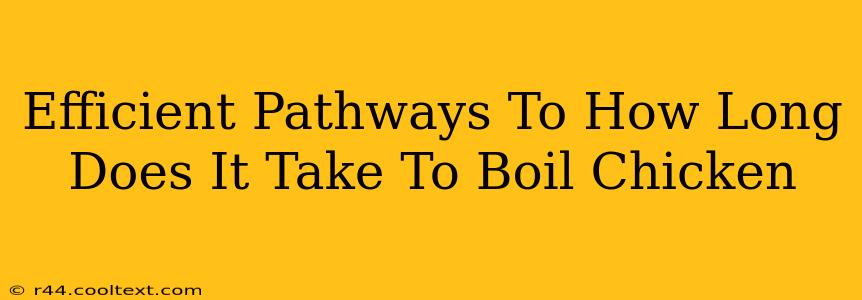Boiling chicken is a simple cooking method, perfect for creating a base for soups, salads, or shredding for tacos. However, knowing precisely how long to boil chicken for optimal results can be tricky. This guide outlines efficient pathways to perfectly boiled chicken every time, factoring in different chicken cuts and desired doneness.
Factors Affecting Chicken Boiling Time
Several factors influence how long it takes to boil chicken:
-
Chicken Cut: A whole chicken will take significantly longer than chicken breasts or thighs. Smaller pieces cook faster due to their smaller surface area and volume.
-
Starting Temperature: Cold water versus hot water impacts cooking time. Starting with cold water allows the chicken to cook more evenly, while hot water shortens the cooking time.
-
Desired Doneness: Are you aiming for juicy, tender chicken, or do you need it fully cooked and easily shreddable? Longer boiling times lead to more tender, potentially drier, chicken.
-
Pot Size: An overcrowded pot will take longer to heat and cook the chicken evenly. Ensure ample space for the chicken to move freely in the boiling water.
Boiling Time Guide for Different Chicken Cuts
This guide provides approximate boiling times. Always use a food thermometer to ensure the chicken reaches a safe internal temperature of 165°F (74°C).
Chicken Breasts:
- Thin Breasts: 10-15 minutes in boiling water.
- Thick Breasts: 15-20 minutes in boiling water.
Chicken Thighs:
- Bone-in, Skin-on: 20-25 minutes in boiling water.
- Bone-in, Skinless: 15-20 minutes in boiling water.
- Boneless, Skinless: 10-15 minutes in boiling water.
Whole Chicken:
- Approximately 1-1.5 hours in boiling water, depending on the size of the chicken.
Tips for Perfectly Boiled Chicken
- Use a large pot: Allow ample space for the chicken to cook evenly.
- Season the water: Add salt, peppercorns, bay leaves, or other herbs to enhance the flavor of the chicken.
- Don't overcrowd the pot: Overcrowding will lower the water temperature and prolong cooking time. Cook in batches if necessary.
- Skim off foam: Skim any foam that rises to the surface during the boiling process.
- Check for doneness with a thermometer: The most accurate way to ensure the chicken is fully cooked is to use a food thermometer. Insert it into the thickest part of the chicken; it should register 165°F (74°C).
- Let it rest: After boiling, let the chicken rest for a few minutes before shredding or slicing. This allows the juices to redistribute, resulting in more tender meat.
Beyond Boiling: Other Cooking Methods for Chicken
While boiling is a great method for certain applications, consider these alternatives depending on your desired outcome:
- Poaching: Similar to boiling, but uses simmering water, resulting in more tender and flavorful chicken.
- Baking: Yields juicy and flavorful chicken, particularly when roasted with herbs and spices.
- Pan-frying: Creates a crispy skin and tender inside, ideal for quick weeknight meals.
- Slow cooking: Perfect for tenderizing tougher cuts of chicken, resulting in fall-off-the-bone texture.
By following these guidelines and tips, you'll be well on your way to perfectly boiled chicken every time. Remember to prioritize food safety and always check the internal temperature with a meat thermometer. Happy cooking!

